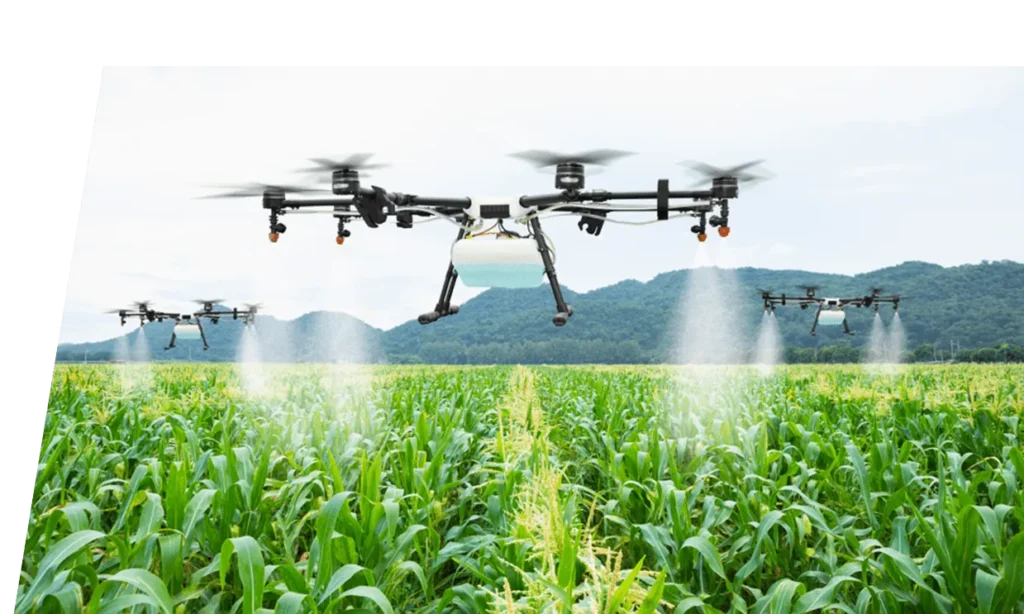Precision farming isn’t just a trend but a practical solution to modern farming challenges. With rising input costs, labor shortages, and the need for better resource management, traditional methods are falling short. That’s why more Indian farmers are turning to tech-powered solutions that work in the field.
One of the most impactful tools in this shift has been Agricultural Drones. These unmanned aerial systems transform how fields are monitored, mapped, and managed.
With data-driven insights and high-efficiency spraying capabilities, they offer clear, measurable value across every stage of the crop lifecycle.
Let’s break down the top advantages these drones bring to the Indian farmers.
Top 10 Advantages of Agricultural Drones That Improve Efficiency and Crop Performance
The following advantages show how agricultural drones directly improve decision-making, spraying accuracy, and overall farm output, making them an essential part of modern precision farming.
1. Precise Spraying Means No More Guesswork
Manual spraying often results in oversaturation or under-application, especially on large or irregular fields. Agricultural drones change this completely.
They’re programmed to follow precise flight paths and regulate droplet size and volume based on crop type and field conditions. The result? Reduced pesticide usage, uniform coverage, and far fewer input losses.
2. Time-Saving Operations on Large Farms
Covering several acres by foot or tractor can take hours—or even days. Drones do the same job in minutes.
A 10–20 liter tank drone can spray 1–2 acres in under 10 minutes. This speed is not just about convenience—it allows for timely interventions, especially during disease outbreaks or pest infestations, where delay can cost an entire yield.
3. Optimized Input Usage
Every liter of chemical or drop of water matters—especially when margins are tight. Drones ensure that only the required quantity is sprayed where it’s needed.
Their ability to apply inputs site-specifically means less waste and reduced groundwater contamination. This precision helps control input costs while keeping long-term soil health intact.
4. Better Crop Monitoring with Aerial Imagery
Multispectral cameras attached to drones can identify stress in crops that are invisible to the naked eye. You get NDVI (Normalized Difference Vegetation Index) maps, plant health scores, and canopy coverage stats without setting foot on the farm.
Regular drone monitoring lets you catch nutrient deficiencies, water stress, or pest issues early and act before they damage the crop.
5. Safer for You and Your Workers
Spraying chemicals by hand isn’t just tiring—it’s hazardous. With drones, operators can stay at a safe distance, reducing exposure to harmful substances.
This also addresses one of Indian agriculture’s pressing issues: the shortage of trained labor willing to take on such risky, low-paying work. Drones reduce human exposure and lower dependency on a shrinking rural workforce.
6. Reduced Soil Compaction
Heavy tractors and sprayers leave behind compacted soil, which limits water absorption and root growth. Drones, on the other hand, are airborne and non-intrusive.
No tires, trampling, or soil disruption—especially critical in wet or newly tilled fields where soil structure needs to be preserved for healthy crop development.
7. Real-Time, Data-Backed Decisions
The power of drones lies not just in what they do, but in what they show. Most advanced agricultural drones come with cloud connectivity and analytics dashboards.
You can access real-time flight data, spraying logs, and health maps from your phone or laptop. This data helps you make smarter, faster decisions without relying solely on field scouting.
8. Supports Government-Backed Sustainability Goals
The government of India has been promoting drone use in agriculture through several schemes, including the Namo Drone Didi initiative. These programs are designed to increase rural entrepreneurship, reduce input dependency, and encourage sustainable farming.
When you use drones, you’re improving your operations and aligning with national goals that encourage smarter farming and tech adoption at scale.
9. Enables Precision Replanting After Crop Damage
Unexpected events like flooding, pest attacks, or wind damage often wipe out sections of a field. Agricultural drones with high-resolution imaging and GPS mapping allow you to assess the areas affected quickly. This real-time insight lets you replant precisely, only where needed, saving time, seeds, and labor. Instead of redoing entire patches, you restore productivity in a highly targeted way.
10. Minimizes Human Error in Large-Scale Operations
Even minor errors can cause significant losses on large farms—missed patches during spraying, wrong dosage, or uneven application. Manual operations are prone to fatigue, inconsistent spray rates, and misalignment, especially during peak hours.
Agricultural drones operate based on pre-set flight maps, altitude, and flow rates, ensuring uniform coverage every time. This automation reduces dependency on manual skills, eliminates overlaps, and prevents untreated areas. This accuracy translates into healthier crops and measurable savings on chemical inputs for farms managing hundreds of acres.
Conclusion: Why Drones Are the Future of Indian Farming
Agricultural drones are more than just machines. They’re enablers of precision, productivity, and profitability. Their benefits are clear and immediate, from boosting efficiency to reducing environmental impact.
And if you’re planning to start your drone journey, partner with a company that understands Indian agriculture from the ground up. Leher offers drone spraying solutions and delivers training, support, and scalability. Whether you’re a farmer or an aspiring drone entrepreneur, Leher ensures that the tech works, where it matters most: in the field.



